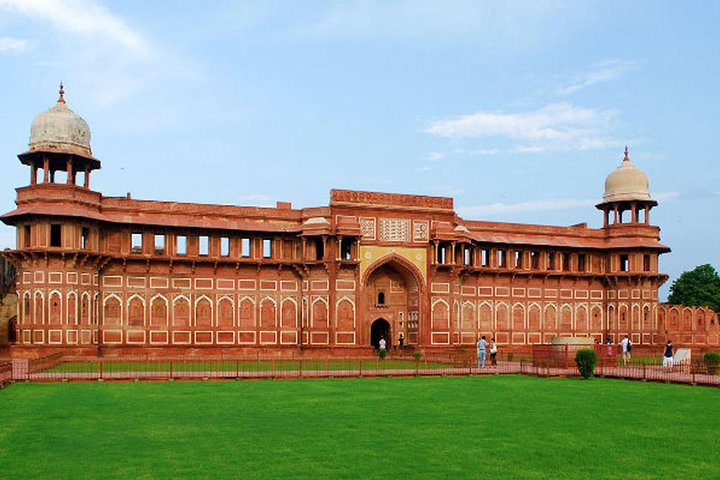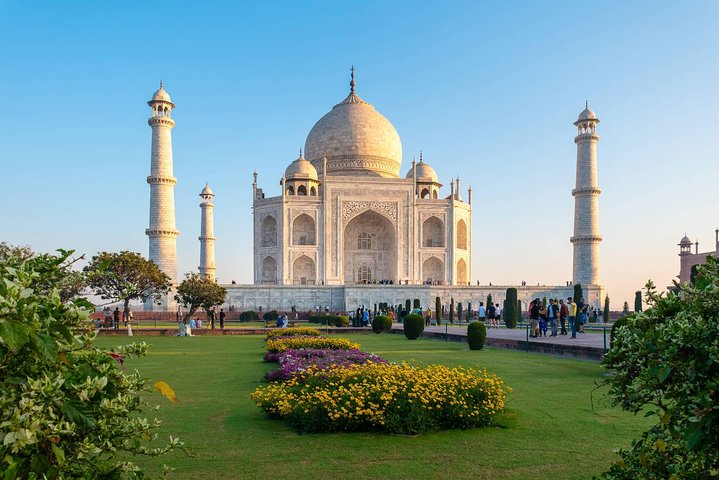3 Days Golden Triangle Tour With 5 Star Hotel
Share this tour

Offered languages
- English
- Spanish
This 3 days Golden Triangle tour itinerary guides you to the most magical cities of India - Delhi, Agra and Jaipur. In Delhi visit Qutub Minar, Humayun's Tomb, Bahai Temple (Lotus Temple), India Gate, the Parliament House, the President's House and go bazaar shopping. In Agra visit the Taj Mahal, Agra Fort (Red Fort) and go bazar shopping. In Jaipur visit the Amber Fort, Lake Palace (Jal Mahal), the Palace of Winds (Hawa Mahal), the Maharaja's City Palace, Jantar Mantar Observatory and go bazaar shopping..
What's Included
Breakfast
Meeting and pickup
Our driver Will meet you at your location in Delhi Airport or any hotel.
Itinerary
-
1New Delhi
Pickup airport or any location in Delhi and visit India Gate, parliament house,Humayu's tomb and Qutub minar.
Admission ticket free -
2Humayun's Tomb
Humayun's tomb is the tomb of the Mughal Emperor Humayun in Delhi, India. The tomb was commissioned by Humayun's first wife and chief consort, Empress Bega Begum, in 1569-70, and designed by Mirak Mirza Ghiyas and his son, Sayyid Muhammad, Persian architects chosen by her.
1 hour • Admission ticket not included -
3Qutub Minar
The Qutb Minar, also spelled as Qutab Minar or Qutub Minar, is a minaret that forms part of the Qutb complex, a UNESCO World Heritage Site in the Mehrauli area of Delhi, India. Qutb Minar is a 73-metre tall tapering tower of five storeys, with a 14.3 metres base diameter, reducing to 2.7 metres at the top of the peak
1 hour • Admission ticket not included -
4India Gate
The All India War Memorial, popularly known as the India Gate, is located along the Rajpath in New Delhi. The imposing structure of India Gate is an awe-inspiring sight and is often compared to the Arch de Triomphe in France, the Gateway of India in Mumbai and the Arch of Constantine in Rome. This 42-meter tall historical structure was designed by Sir Edwin Lutyens and is one of the largest war memorials in the country. India Gate is also famous for hosting the Republic Day Parade every year. If you are keen to know more about World War I, you should head out to India Gate. It is also a treat for architecture lovers.
30 minutes • Admission ticket free -
5Parliament House
Parliament House or Sansad Bhavan is one of the most impressive buildings in Delhi. Located at the end of Sansad Marg the Parliament Building was designed by British architect Edwin Lutyens and Herbert Baker. This iconic building was inaugurated in 1927 by Lord Irwin, the then Governor-General of India.
30 minutes • Admission ticket free -
6Agra
After finish Delhi sightseeing drive to Agra. on arrival in Agra check-in hotel.
4 hours • Admission ticket free -
7Agra
After breakfast, checkout and visit Taj Mahal , Agra Fort and Fatehpur sikri. overnight stay in Jaipur.
Admission ticket free -
8Taj Mahal
What is widely considered as the most beautiful building in the world, Taj Mahal is located in the historical city of Agra. It was built by the Mughal Emperor Shah Jahan as a memorial for his third wife, Mumtaz Mahal. Constructed entirely out of white marble in the 17th century, it is among the finest edifices of Mughal architecture. Recognised by the UNESCO as a world heritage site, this monument is also considered to be one of the seven wonders of the modern world. Every year visitors numbering more than the entire population of Agra pass through the magnificent gates to catch a glimpse of this breathtaking monument, and only a few leave disappointed. Shah Jahan said about the Taj that it made "the sun and the moon shed tears from their eyes".
2 hours • Admission ticket not included -
9Agra Fort
Agra Fort is one of the most special monuments built by the Mughals and has richly decorated buildings. It is the perfect example of the Mughal style of art and architecture and is one of the most visited tourist spots in Agra. Built purely out of red sandstone, this expansive architecture stands out against the soft azure of the sky. Within the premises of the fort lie the most exquisite structures of the Mughals like the Pearl Mosque, Diwan-i I Khas, Diwan-i I Aam, Moti Masjid and Jahangiri Mahal. Each and every one of these edifices has remarkable handiwork and ornamentation that make this place a delight for every history and architecture lover. You can also get a splendid view of Taj Mahal from the Agra Fort!
1 hour • Admission ticket not included -
10Panch Mahal - Fatehpur Sikri
A city, predominantly made of red sandstone, Fatehpur Sikri was founded in 16th century by Mughal Emperor Akbar. It is essentially a fortified city built by the king and had been the capital of his Empire for fifteen years. Now a UNESCO world heritage site and a famous tourist attraction, it is a fine example of Mughal architecture. Fatehpur Sikri is home to Jodha Bai's palace, Jama Mosque, Buland Darwaza, and a Tomb of Salim Chisti among many other famous monuments, each of which, is an integral part of the Indian heritage.
2 hours • Admission ticket not included -
11Jaipur
After finish sightseeing drive to Jaipur. on arrival check-in hotel. overnight stay in hotel.
4 hours • Admission ticket free -
12Jaipur
After breakfast, visit Amber fort, hawa mahal, Jal Mahal, City palace, Jantar mantar
Admission ticket free -
13Amber Palace
In the Pink City of Jaipur, cradled on the top of the Aravali Hill lies the Amer Fort, one of the most magnificent palaces in India. Also commonly known as the Amber Fort, this majestic building with its maze-like passages and serpentine staircases is an architectural masterpiece and with significant importance in Indian history. Only 11 kilometres away from the capital city of Jaipur, Amer Fort is clad in pink and yellow sandstone and is a part of an extensive complex. Built by one of the most trusted generals of Akbar, Maharaja Man Singh I in the year 1592, Amer Fort served as the main residence of the Rajput Rulers.
2 hours • Admission ticket not included -
14Hawa Mahal - Palace of Wind
Hawa Mahal is a structure made of red and pink sandstone and has a pyramidal structure which almost resembles a crown. It has been embellished with 953 tiny windows, also known as 'Jharokhas' and embellished with gorgeous latticework. From within, the Hawa Mahal palace is based on five floors each of which has a uniquely decorated chamber. A charming fountain welcomes you inside the main palace, from whereon you can make your way up to the different floors. The top of the palace offers a brilliant view of the City Palace, Jantar Mantar and the ever-busy Siredeori Bazar. There is a small museum as well which holds some rich relics and miniature paintings.
1 hour • Admission ticket not included -
15City Palace of Jaipur
The City Palace complex is spread over a large area occupying one seventh of the old city of Jaipur. It has a sequence of gardens, buildings and courtyards, temple and museum to give it a grand view that reflects its historical importance and magnificent royal grace. Its outer boundary was built by Raja Jai Singh and other structures by his successors to add charm to it. It also served as a residence for former Maharaja of Jaipur.
1 hour • Admission ticket not included -
16Jantar Mantar - Jaipur
The Jantar Mantar is a collection of nineteen architectural astronomical instruments built by the Kachwaha Rajput king Sawai Jai Singh II, the founder of Jaipur, Rajasthan. The monument was completed in 1734. It features the world's largest stone sundial, and is a UNESCO World Heritage site
1 hour • Admission ticket not included -
17New Delhi
Evening transfer you to Delhi as per your flight schedule driver transfer you to Delhi airport.
5 hours • Admission ticket free
Delhi - Agra ( 220 Kms)
Agra- Fatehpur Sikri - Jaipur
Jaipur - Delhi (240 Kms)
Additional info
- Not recommended for travelers with spinal injuries
- Not recommended for travelers with poor cardiovascular health
- Not recommended for pregnant travelers
- Suitable for all physical fitness levels
Tags
Cancellation Policy
All sales are final. No refund is available for cancellations.
Show more
Cancellation Policy
This experience is non-refundable and cannot be changed for any reason. If you cancel or ask for an amendment, the amount you paid will not be refunded.
Rating
You will not receive a refund if you cancel.
Your guide to the flawless travel experience












